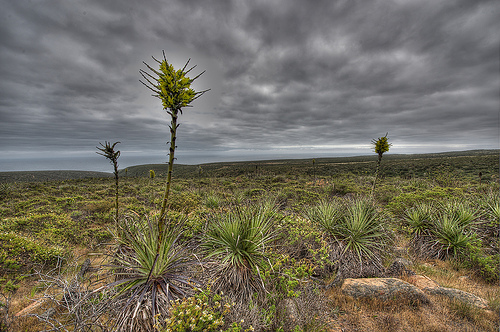Sheep-eating plant blooms in UK greenhouse
Puya chilensis has an interesting strategy for getting the nutrients it needs
For fifteen years a plant named Puya chilensis has been growing in the greenhouse of the Royal Horticultural Society's Garden Wisley. And finally this year the plant has bloomed, sending up a mace-like spire of spiky, forbidding flowers to match the rosette of sharp, hook-shaped spines that grow at the plant's base. This lovely little Chilean plant is now ready to eat some sheep, and look florally fabulous as it does so.
Puya chilensis is a bromeliad, a distant relative of the pineapple (among many other plants). This plant is native to the arid highlands of Chile, where the soil is thin and nutrients are scarce. These sparse desert regions would be a tough place for most large plants to find enough nutrients to support their growth. But the Puya chilensis is a large plant indeed: it commonly grows up to six feet tall.
How does the spiky Puya chilensis accomplish this feat?
By trapping and digesting sheep and birds.
The many hooks and sharp thorns at the base of the plant snag the wool of passing sheep, and can also entrap birds. The trapped animals eventually die of starvation or thirst. After which point, their corpses slowly decay into the ground, providing nutrients which the Puya chilensis eagerly consumes.
Luckily, there is no need to feed sheep to the Royal Horticultural Society's Puya chilensis. In captivity the plant thrives on a base of liquid fertilizer.
Of course, the Puya chilensis is hardly the world's only dangerous plant. If you're talking poison, the white oleander and the water hemlock are some of the most toxic plants in the world, and they are common in North America.
The oleander is pretty and is commonly grown as a cultivated garden plant, but can cause cardiac arrest within seconds of ingesting its flowers or leaves. The hemlock grows wild in marshy disturbed areas, and every part of the plant is just as toxic today as it was in Socrates' time. It's so toxic that gardeners trying to dispose of it are advised to wear thick gloves, full-body clothing that leaves no skin gaps, and to dispose of the plant in the garbage, not in the yard waste or compost.
This strange plant is definitely one for the record books. I think someone should try to figure out how to breed it with a Titan arum. Then it can smell like death and devour dead sheep, thus becoming the world's scariest plant!
